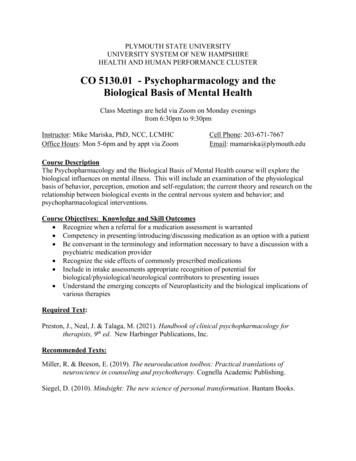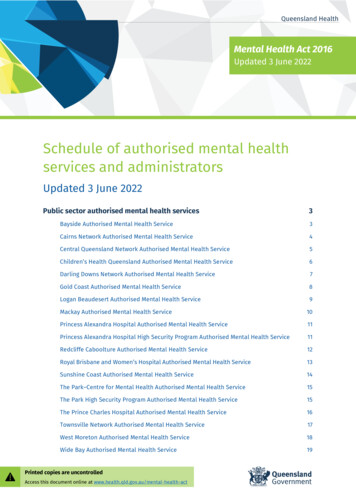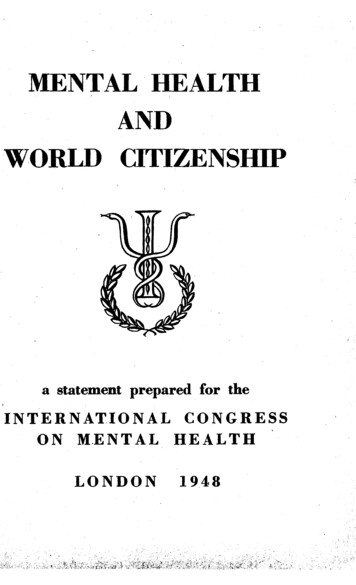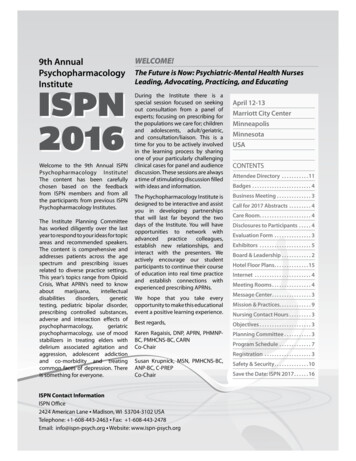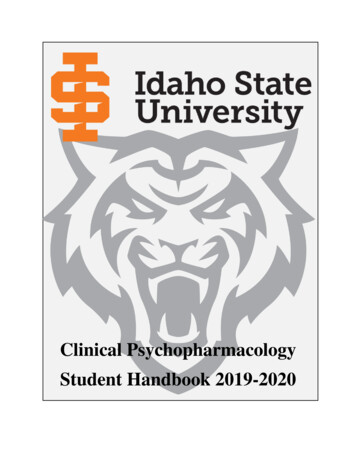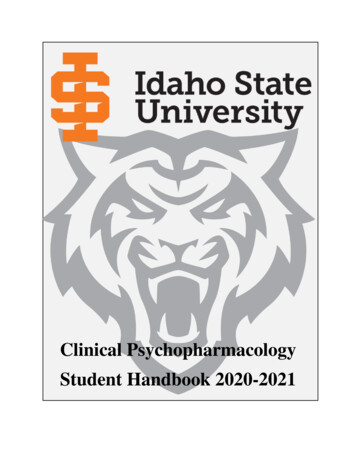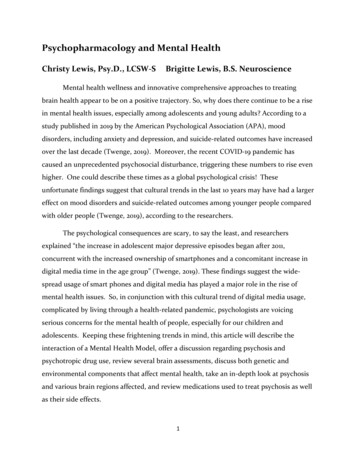
Transcription
Psychopharmacology and Mental HealthChristy Lewis, Psy.D., LCSW-SBrigitte Lewis, B.S. NeuroscienceMental health wellness and innovative comprehensive approaches to treatingbrain health appear to be on a positive trajectory. So, why does there continue to be a risein mental health issues, especially among adolescents and young adults? According to astudy published in 2019 by the American Psychological Association (APA), mooddisorders, including anxiety and depression, and suicide-related outcomes have increasedover the last decade (Twenge, 2019). Moreover, the recent COVID-19 pandemic hascaused an unprecedented psychosocial disturbance, triggering these numbers to rise evenhigher. One could describe these times as a global psychological crisis! Theseunfortunate findings suggest that cultural trends in the last 10 years may have had a largereffect on mood disorders and suicide-related outcomes among younger people comparedwith older people (Twenge, 2019), according to the researchers.The psychological consequences are scary, to say the least, and researchersexplained “the increase in adolescent major depressive episodes began after 2011,concurrent with the increased ownership of smartphones and a concomitant increase indigital media time in the age group” (Twenge, 2019). These findings suggest the widespread usage of smart phones and digital media has played a major role in the rise ofmental health issues. So, in conjunction with this cultural trend of digital media usage,complicated by living through a health-related pandemic, psychologists are voicingserious concerns for the mental health of people, especially for our children andadolescents. Keeping these frightening trends in mind, this article will describe theinteraction of a Mental Health Model, offer a discussion regarding psychosis andpsychotropic drug use, review several brain assessments, discuss both genetic andenvironmental components that affect mental health, take an in-depth look at psychosisand various brain regions affected, and review medications used to treat psychosis as wellas their side effects.1
Brain health plays a major role in how we function in society and is directly relatedto our physical health. In fact, since science and technology are advancing exponentially,health professionals can now offer advanced comprehensive strategies to treat psychiatrichealth issues. Unfortunately, the vast majority of patients say they have never heardabout integrative strategies to treat mental health. This may be because individuals whoare experiencing mental health issues are simply not seeking the help they need due tonegative stigma. Another reason may be family practitioners are simply not educatingand/or referring their patients to mental health professionals that offer comprehensivestrategies. Either way, the consequence of not addressing mental health issues as a childor adolescent can extend their issues into adulthood, limiting opportunities to leadfulfilling and productive lives as adults. Current models for understanding the importanceof the interaction of our biology, psychological health, and social relationships help usunderstand the need for balance, and make clear how these factors play a major rolethroughout an individual’s lifespan:Mental Health Model:PsychologyBiologycoping skillsphysical healthsocial skillsdrug vulnerabilitiesfamily relationshipsdrug effectsself-esteemSocialpeer relationshipsfamily relationshipsfamilycircumstancesWhen one is healthy, the delicate interaction between one’s biology, social relationshipsand one’s psychological well-being produces a mind/body equilibrium, a biopsychosocial2
balance, and as a result we feel healthy, happy, and secure. So, if any of these sections inthe mental health model become disconnected, one will experience stress which couldlead to serious mental health issues, including psychosis.In addition to the cultural trend of digital media usage, the COVID-19 crisis hasclearly affected society’s social dynamics and how we are able to relate to and interactwith others, causing social isolation, loneliness, and feelings of fear/anxiety. This is aparadox because the very thing (digital media) that has contributed to a rise in seriousmental health issues in the past, is now something we need to keep us connected andimprove our mental health! We now need to find a digital media balance combined withstrategic treatment models for mental health practitioners to treat patients so thesestaggering statistics can improve. The concerns about the virus and its effects havecaused feelings of uncertainty, which has developed in many parts of the world, into acycle of panic and fear. Consider the fact that when one is stressed, old psychologicalpatterns can emerge, creating discord with family and/or friends. This compounds ourpsychological stress, and invariably leads to other major health issues.Given these considerations, the first step of treatment should consist of animproved understanding and approach to a combination of therapy strategies thatinclude psychotherapy, behavior therapy, and psychopharmacology. Now that mentalhealth is a widespread issue, this combined approach is getting more attention as thefield of neuroscience continues to uncover new ways to treat a variety of mentaldisorders. In combination with psychotherapy, promising breakthroughs andadvancements in psychotropic medications may result in refining drug treatments formental disorders by offering safer and more effective selections with less negative sideeffects. In this article, the neurochemical effects of psychotropic drugs will be discussed,with an emphasis on the drug Seroquel, as well as both positive and negative side effectsthat may occur as a result of taking psychotropic medication(s).Psychosis and Psychotropic Drugs3
Let’s face it. Many individuals want to avoid taking psychotropic drugs because ofthe adverse side effects that may ensue. Nevertheless, there are individuals with severemental health issues that need medications to help them function in everyday life. Thereare many clinical syndromes that fall into serious mental illness categories, so this paperwill focus on severe syndromes such as bipolar disorder, schizophrenia, or dementia, thatcan develop into psychosis. Only a small portion of the population with genetic,epigenetic, and developmental risk factors, along with exposure to social andenvironmental factors, may be prone to developing persistent psychotic symptoms(Arciniegas, 2015), but psychologists suspect this number might be on the rise since thenovel COVID-19 pandemic attacked our population. Developing a psychotic disorder,such as Schizophrenia, is persistently found to be around one percent of the population inany given culture and environment. However, since the COVID-19 crisis, our populationas a whole has been exposed to considerable risk factors, along with social andenvironmental factors, so a larger portion may be affected, including individuals who arenow suffering with PTSD.The definition of psychosis is multifaceted. It is important, therefore, to define thecondition and list how it is classified as a mental disorder so one can better understandhow medication can help. Psychosis is defined by abnormalities in one or more of thefollowing domains: positive symptoms (delusions, and hallucinations), disorganizedthinking (speech), grossly disorganized or abnormal motor behavior (includingcatatonia), and negative symptoms (decreased ability to experience pleasure (anhedonia),diminished speech output (alogia), decreased social association (asociality), anddiminished emotional expression) (Arciniegas, 2015, and Kupfer, 2013). All of thesesymptoms cause distress to the patient, along with major impairment in personalfunction, and extreme distress to the patient’s family and friends.Psychotropic drugs are prescribed to a patient after diagnosis to help diminish thepositive and negative symptoms and hopefully improve their quality of life. To furthercomplicate the condition, psychosis is typically comorbid with schizophrenia spectrumdisorders, mood and substance use disorders, and many developmental, acquired, and4
degenerative neurologic and medical conditions (Arciniegas, 2015). Before describing thedifferent sections of the brain that are dysregulated in patients who are afflicted withpsychosis, common neurobiological factors in this spectrum of patients will be addressedin order to better understand how antipsychotic drugs can affect an individual’s uniqueneurobiology. Finally, common neurotransmitters, which are found in deficit or excess,will be examined along with the systems they affect.AssessmentPsychosis, along with various other serious mental health issues, is usuallydiagnosed by using both informal and structured clinical assessments for the presence ofpositive and/or negative symptoms that are clearly defined common features of psychosis(Arciniegas, 2015). There are many observable behaviors and neurobiological factorsclinicians must consider before properly diagnosing and treating someone with a mentalhealth problem. An example of a clinical assessment used to diagnose someone withpsychosis is the use of biomarkers (Venigalla, 2017). This is a fairly new approach indiagnosing mental disorders and can help physicians prescribe psychotropicmedication(s) that better match the individual’s unique chemical imbalances.A biomarker is defined as a characteristic that is objectively measured andevaluated as an indicator of normal biologic processes, pathologic processes or biologicalresponses to a therapeutic intervention (Venigalla, 2017). In other words, a biomarker canbe a gene or a group of genes, proteins or other biomolecules (Venigalla, 2017). It isimportant to note that the development of psychosis is the result from both gene andenvironment interaction. For example, Schizophrenia is a neurodevelopmental disorderthat results from the abnormal development of the prefrontal cortex and hippocampus(Meyer, 2019). The first line of treatment for schizophrenia is usually to reactivate thehomeostatic nature of the patient’s dopamine system (Meyer, 2019). Unfortunately, thepersistent disconnection between the anatomical and pharmacological aspects of thedisorder is still unknown.5
Observing biomarkers is a new type of diagnostic procedure that can be a veryuseful tool for healthcare practitioners. As noted above, biomarkers are very complex—since there is not just one abnormality that contributes to severe mental illness, but acombination of various abnormalities. Interestingly, certain electrophysiologicalbiomarkers can show the failure of connectivity among neurons and abnormal neuronalprocessing (Nenadic, 2015), and are found by using a quantitative electroencephalography(qEEG), or a brain map, which is a precise tool in locating brain dysregulation.Biomarkers commonly found in schizophrenics are characterized by frontal lobe deficits,or hyperfrontality. A qEEG processes recorded EEG activity from a multi-electroderecording using a computer with specialized software. Finally, many types of brainimaging techniques can be used to view these abnormalities in brain activity. These canbe detected using a functional magnetic resonance imaging (fMRI) (Nenadic, 2015). AnfMRI uses a fast chain of MRI images to monitor blood flow in the brain detecting areas ofactivity.Another brain imaging technique is called Single Photon Emission ComputedTomography (SPECT imaging), and is a procedure widely used to study brain issues. Ituses a radioactive substance and a special camera to look at 3D images of the brain andmeasure cerebral blood flow. A common functional abnormality found in a patient whoexhibits signs of psychosis is less of an increase in blood flow to the prefrontal cortex(PFC) while performing cognitive tasks that require executive functioning (Nenadic,2015). Functional imaging data of schizophrenics suggests that there is decreasedactivation in the PFC when trying to preform cognitive tasks. Another biomarker forindividuals who have been diagnosed with schizophrenia is abnormal eye movements.This abnormality is known as smooth-pursuit eye movements and is known as abiomarker of hypofrontality (Meyer, 2019). In individuals with schizophrenia, their eyestend to dart and then attempt to readjust when tracking an object. This shows that thereare obvious deficits in controlling eye movements. Furthermore, this finding suggests thatthere must be some dysregulation in the frontal eye fields (FEFs), which are located in thePFC (Meyer, 2019).6
GeneticsGenetics play a role in many serious mental health disorders, and one mentalhealth disorder that has a strong heritability rate is schizophrenia. Presumably,individuals who share greater proportions of their DNA with a schizophrenic will haveincreased risk of developing the disorder. Heritability of this neurodevelopmentaldisorder is estimated to be approximately seventy-six percent (Hiker, 2018). Althoughthese studies indicate a strong genetic component in schizophrenia, scientists do notknow what genes are directly involved. This is a very complicated process because thedisorder is both polygenic and pleiotropic (Zheutlin, 2019). Therefore, the commongenetic loci for individuals with schizophrenia have been grouped into three broadcategories.One category are genes that code for synaptic proteins involved in neuronalexcitability and plasticity. This category would be genes that code for NMDA receptors,cytoskeletal proteins, or long lasting (L type) calcium channels (Iasevoli, 2014). Anothercategory is cell to cell recognition molecules that play a role in synapse formation andstabilization. Synapse formation and stabilization involves genes such as the DISC-1 gene,and Neuregulin 1 (NRG-1) and its receptor erbB-3 (Selemon, 2015). The last categoryincludes other types of structural proteins. These include the peptide FMRP and otherrelated proteins (Iasevoli, 2014). Although we do not know exactly what causes thedeficits in schizophrenia, they seem to be related to establishing neuronal synapses,keeping those synapses working, and maintaining all of the molecules at the synapse intheir proper location so that the synapse can function typically. Thus, one may concludethat genetic vulnerability that alters neurodevelopment might include developmentaldeficits in cell differentiation, migration, or synaptogenesis.Environment, Pregnancy, and Fetal DevelopmentThe environmental stressors that seem to affect the development ofneurodevelopmental disorders tend to revolve around prenatal complications in the earlystages of development. Some common complications that can cause the development of7
neurodevelopmental disorders include maternal illness, poor maternal nutrition, and lowbirth weight or premature birth (Selemon, 2015). It is believed that the immune responsepresented by a mother who is sick with either influenza or rubella can change thedevelopmental trajectory of a genetically as risk fetus (Selemon, 2015). It has beentheorized that cortical development in the first trimester must be derailed by someenvironmental factors in early gestation (Selemon, 2015). For example, schizophrenics areknown to have decreased neuronal volume, most likely initiated by reducing neuronalproliferation in early gestation (Selemon 2015). An environmental factor that mightdisrupt the development of the fetus’s cortex is the inflammatory immune response of themother (Selemon, 2015). The interaction between genes and environment leads to thedevelopment of symptoms that usually emerge in late adolescence to early adulthood(Selemon, 2015). These interactions change developmental trajectories, leading toanatomical and functional deficits.Psychosis – Brain Regions AffectedNumerous regions of the brain are affected by the presence of psychosis. Areas ofcortical deficits include, right dorsolateral prefrontal, bilateral medial prefrontal, bilateralventrolateral prefrontal and insular cortical areas, left medial temporal, as well asthalamus (bilateral), left superior temporal cortex, and minor right cerebellar and righttemporal pole areas (Nenadic, 2015). It is understood that individuals suffering fromschizophrenia have gross anatomical changes. Particularly in males that display negativesymptoms, there are enlarged ventricles (Johnstone, 1976). In fact, there is an overalldecrease in brain volume, seen in total brain size (Meyer, 2019). This includes areas likethe prefrontal cortex and hippocampus, along with a widening of brain sulci (Meyer,2019). The brain volume loss in schizophrenics is not a whole scale neurodegenerationlike we see in Parkinson’s and Huntington’s disease. Instead, the area of synaptic contactsis largely what is lost (Meyer, 2019). There is no loss of cells bodies, but loss of all thesynaptic contacts due to abnormal or excessive pruning of synapses (Meyer, 2019).Additionally, there is disorganized brain anatomy seen in the prefrontal cortex and8
hippocampus. The disorganized anatomy seen in schizophrenia leads to functionaldeficits (Meyer, 2019). It is believed that the negative and cognitive symptoms ofschizophrenia are the result of inefficient PFC function (Meyer, 2019).Given this glimpse into the brain, one can conclude that symptoms of psychosis,including some types of dementia and schizophrenia, are mainly related to deficits in theprefrontal cortex (PFC). Hypofrontality, which is a state of decreased cerebral blood flow,causes impaired executive functioning of the prefrontal cortex (Meyer, 2019) and ispresent in individuals afflicted with severe mental illnesses such as schizophrenia, bipolardisorder, and major depressive disorder (MDD). The PFC is responsible for decisionmaking, planning, personality expression, motor control, working memory, inhibition ofinappropriate behaviors, and attention (Meyer, 2019). Cognitive deficits commonly seenin patients suffering from psychosis affect workingmemory, language and executive function, episodicmemory, speed processing, attention inhibition, andsensory processing (Brisch, 2014). With damage tothe PFC, there are deficits in working memory, socialand cognitive impairments, poverty of speech, flataffect, and a lack of motivation (Meyer, 2019). Theseresemble the negative symptoms seen in individuals with schizophrenia, for example.Thus, in individuals with severe mental disorders that include psychosis we see that thePFC is unable to execute top-down control over subcortical systems resulting in the socialand emotional deficits.Working memory discrepancies of patients suffering from psychosis has beenextensively studied by neuroscientists by examining the PFC and cognitive function.However, there are additional challenges among patients afflicted with psychosis.Auditory processing involving memory procedures is impaired as well in working memory(Brisch, 2014). In a clinical test setting, patients demonstrated significant limited capacityof their working memory, as shown by an increased rate of false positives and errors(Nenadic, 2015).9
Episodic memory discrepancies seen in patients suffering from psychosis involvedeficits in the medial temporal cortex, particularly the hippocampus, and in the PFC,particularly the ventral and dorsolateral regions (Brisch, 2014). Furthermore, increases inboth phasic and tonic activity in the PFC, commonly seen in patients suffering frompsychosis, leads to an increase in inhibitory post-synaptic currents, which wouldultimately cause inhibition in the thalamus (Avery, 2017).Neurochemical Abnormalities of PsychosisRegarding the more direct neurochemical abnormalities of psychosis,pathophysiological models assume that psychosis is caused by hyperactive dopamine(DA) transmission in the mesolimbic pathways and PFC (Brisch, 2014). This is known asthe DA hypothesis, and it has been around ever since clinicians have attempted to explainthe pathophysiology of psychosis. Parkinson’s disease research has majorly contributed insupporting the DA hypothesis. As shown in the above image, Parkinson’s disease ischaracterized by a significant DA deficiency in the basal ganglia, located in the center ofthe brain (Brisch, 2014). It is important to note the dopamine theory of schizophrenia hasbeen challenged. Although medications produce their pharmacological effects rapidly,their clinical effects take weeks or months to kick in. This is known as a therapeutic lag.Furthermore, other receptors in other systems are involved along with the dopaminesystem. Finally, there is a need to reconcile the anatomical/developmental abnormalities.10
In fact, through the use of certain drugs such as neuroleptics, drugs that helps toreduce nervous tension by depressing nerve functions, and the DA precursor L-Dopa,clinicians have developed a better understanding of the biology of psychosis (Brisch,2014). Neuroleptics are DA receptor antagonists and, when prescribed, can causeparkinsonian symptoms (Brisch, 2014). These are known as extra pyramidal system (EPS)side effects. These side effects are caused by increased dopamine in the nigrostriatalpathway. The DA precursor L-Dopa is a DA receptor agonist and, when prescribed, canactually cause symptoms of psychosis (Meyer, 2019). This is also true for stimulants suchas cocaine and amphetamine, which increase dopamine levels and have to potential toinduce psychosis. Neuroleptics (typical antipsychotics) medications are high affinity D2receptor antagonists (Meyer, 2019). These findings further conclude the DA receptorhypothesis for psychosis.Due to the promising findings of the DA hypothesis, researchers have sought tofind the direct cause of psychosis by looking at DA subtypes. DA receptors are G-proteincoupled receptors and can be divided into D1, D2, D3, and D4 receptors respectively(Brisch, 2014). Brain imaging studies show that individuals who suffer from narcolepsy, asleep disorder, selectively inhibit D2 receptors in the striatum, and serotonin (5-HT) 2Areceptors in the PFC, which results in increased dopamine activity (Brisch, 2014). It wasalso found that the D2 receptor is required to be at least eighty percent occupied in orderto effectively treat the positive effects of psychosis (Brisch, 2014). Based on this finding,we now know that not all positive and negative symptoms of psychosis are caused by thisreceptor alone. This challenged the DA hypothesis and called for a new theory ofcausation.Scientists then sought to look for the causes of the negative symptoms ofpsychosis. Through research, the cognitive deficits of psychosis were found to correlatewith a decline in DA receptors in the PFC, predominantly at D1 receptors (Brisch, 2014). Itis believed that the negative symptoms of schizophrenia, for example, are caused byexcessive pruning, or loss of brain volume in the PFC (Meyer, 2019). The positivesymptoms are caused by the loss of top down (prefrontal) control of VTA (brainstem)11
dopamine neurons (Meyer, 2019). Since antipsychotics target the dopamine system, theyare effectively treating the positive symptoms and are equally ineffective in treating thenegative symptoms. This opened up the theory that not only were D2 receptorsresponsible for psychosis, but it is primarily due to an imbalance of D1 and D2 receptors inthe PFC (Brisch, 2014). Furthermore, the D2 receptor, in disinhibition, was recognized tobe main reason of promoting positive symptoms of psychosis while the D1 receptor, indisinhibition, was recognized to be the main reason of promoting negative symptoms(Brisch, 2014). In summary, the extreme chaotic release of DA in the brain of a patientsuffering from psychosis, with emphasis on the PFC, was found to be a potential mediatorin the development of psychotic symptoms.There is more than one neurotransmitter involved with psychosis. As mentionedabove, neuroleptic drugs work with D2 receptors, along with 5-HT2A. The hallucinogenicdrug, LSD, exerts its effects by activating the 5-HT2A receptors as an agonist (Meyer,2019). Due to this, atypical antipsychotics were developed to have a lower affinity for theD2 receptor and a higher affinity for the 5-HT2A receptor (Meyer, 2019). The blocking of 5HT2A receptors by atypical antipsychotics was found to be just as useful as theneuroleptics, just with less severe side effects (Meyer, 2019). The specific D2 receptoroccupancy of neuroleptics in the striatum interacts with the antagonistic effects of 5-HT2Areceptors (Brisch, 2014).In studies of psychosis, an increase in D2 receptor density can be found in highaffinity in specific neurotransmitter pathways such as those of glutamate, gammaaminobutyric Acid (GABA), and acetylcholine (ACh) (Brisch, 2014). The presence of D1receptors can be found in GABA interneurons as well, therefore if a drug affects GABAreceptors, it subsequently affects DA receptors (Brisch, 2014). Similarly, certain D1 and D2receptors cooperate with the major glutamate subtype receptor NMDA as a receptormosaic (Brisch, 2014). GABA and glutamate are both known for regulating DA activity inthe brain (Brisch, 2014). Furthermore, D2 receptor antagonists that can act as D1 receptoragonists, improve NMDA synaptic transmission (Brisch, 2014). In summary, to have an12
effective antipsychotic drug, DA must properly interact with other neurotransmitterpathways to get the desired effect.In schizophrenia there is hippocampal dysregulation of dopamine system function.Part of the deficit that arises from the changes in hippocampal structure in developmentis the loss of GABAergic inhibition in the hippocampus (Meyer, 2019). This results in astrong excitatory drive of glutamate from the hippocampus to the Nucleus Accumbens(NAcc) (Meyer, 2019). Therefore, there is far too much disinhibition of the ventralpallidum by the NAcc, which results in increased activation of dopamine neurons in theventral tegmental area (VTA) to the NAcc (Meyer, 2019). This is known as thehypoglutamate hypothesis of Schizophrenia (Meyer, 2019). The VTA is comprised of twomajor kinds of cells: spontaneously active cells; and cells under tonic inhibition by theventral pallidum (population neurons) (Meyer, 2019).The activity state of the ventral subiculum is dependent on environmental context(Meyer, 2019). When activated, it disinhibits the ventral pallidum, therefore removing theventral pallidum’s inhibitory influence on the dopamine neurons of the VTA (Meyer,2019). This increases the firing rates of DA neurons in the VTA (Meyer, 2019). Thus, it setsthe gain of the dopamine system that influences our perception and actions forbehaviorally relevant stimuli (Meyer, 2019). When a behaviorally relevant stimuli arrives,it results in the excitatory inputs from the pedunculopontine tegmental nucleus (PPT) tosend cholinergic and glutaminergic drive to the hippocampus (Meyer, 2019). In fact, thepopulation neurons can become spontaneously active allowing burst firing in thedopamine neurons to go and influence the system (Meyer, 2019). In summary, controllingthe number of dopamine neurons firing spontaneously controls the gain of the systemthat is able to respond when any behaviorally relevant signal arrives.Drugs that Treat PsychosisHenri Laborit, a French surgeon during World War II, noticed that antihistamineshad a sedative effect (Linda, 2017). He later collaborated with a pharmaceutical companycreating a specialized phenothiazine in order to reduce psychosis in patient’s post-surgery13
(Linda, 2017). The medication he used was called chlorpromazine (CPZ), and he laterobserved that it caused a state of sedation in the patients, but without narcosis (Linda,2017). Impressed by this observation, Laborit used this medication to reduce psychosis inpatients who experienced severe psychotic symptoms (Linda, 2017). This resulted in amajor advancement in the use of this drug to treat various symptoms of psychosis.The drug CPZs chemical makeup was used to make antipsychotic drugs and leadto the development of other ways to properly sedate people who suffered from psychosis(Linda, 2017). These original antipsychotics, such as CPZ, caused the occurrence ofextrapyramidal symptoms (EPS) or movement disorders (Linda, 2017). They worked byblocking DA receptors, therefore increasing DA release, and relieving psychoticsymptoms (Linda, 2017). Approaching this problem of EPS from excessive DA blockade,atypical antipsychotics were created, combining both DA and 5-HT blockade to increasefree DA in the synapse (Linda, 2017). One atypical antipsychotic drug created wasSeroquel.Seroquel, as well as many other commonly prescribed psychotropic drugs, is anatypical antipsychotic medication used to treat many serious cases of psychosis such asschizophrenia, bipolar disorder, and dementia, and may be used off label for otherneurological disorders that have an unstable mood component such as major depressionand in some cases anxiety (Dine, 2015). Atypical is defined as a second-generationantipsychotic medication that is FDA approved to treat certain psychiatric conditions(Dine, 2015). While seroquel has less EPS occurrences than other atypical antipsychotics,it is considered a sedative and causes weight gain (Linda, 2017). Because of the drugssedative effects, it is occasionally prescribed to patients suffering from post-traumaticstress disorder (PTSD) and to help with sleep (Linda, 2017). Seroquel acts on D2 receptorsand 5-HT2A receptors as an antagonist to get the desired effect.This combination of medications decreases mesolimbic and dopaminergicpathway hyperactivity, therefore acting as a D1 receptor agonist in the PFC and improvingNMDA synaptic transmission (Brisch, 2014, and Linda, 2017). Once a patient continuously14
takes Seroquel, it is not an easy process to stop because it can lead to withdrawal effects,and a possible return to the original problem (Hager, 2015). In fact, once the brainaccommodates to the everyd
Psychopharmacology and Mental Health Christy Lewis, Psy.D., LCSW-S Brigitte Lewis, B.S. Neuroscience Mental health wellness and innovative comprehensive approaches to treating brain health appear to be on a positive trajectory. So, why does there continue to be a rise in mental health issues, especially among adolescents and young adults?

